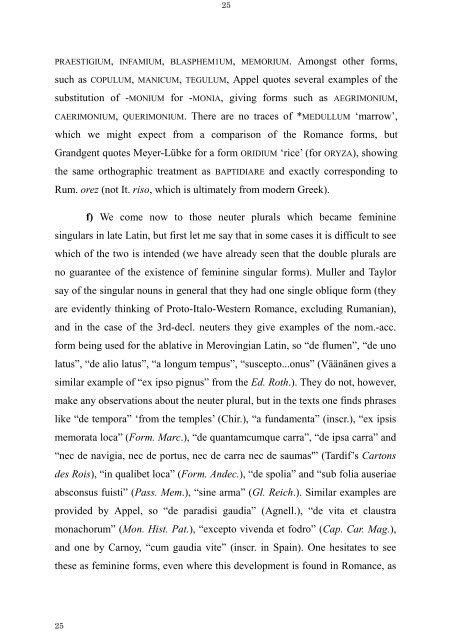The Latin Neuter Plurals in Romance - Page ON
The Latin Neuter Plurals in Romance - Page ON
The Latin Neuter Plurals in Romance - Page ON
Create successful ePaper yourself
Turn your PDF publications into a flip-book with our unique Google optimized e-Paper software.
25<br />
25<br />
PRAESTIGIUM, INFAMIUM, BLASPHEM1UM, MEMORIUM. Amongst other forms,<br />
such as COPULUM, MANICUM, TEGULUM, Appel quotes several examples of the<br />
substitution of -M<strong>ON</strong>IUM for -M<strong>ON</strong>IA, giv<strong>in</strong>g forms such as AEGRIM<strong>ON</strong>IUM,<br />
CAERIM<strong>ON</strong>IUM, QUERIM<strong>ON</strong>IUM. <strong>The</strong>re are no traces of *MEDULLUM ‘marrow’,<br />
which we might expect from a comparison of the <strong>Romance</strong> forms, but<br />
Grandgent quotes Meyer-Lübke for a form ORIDIUM ‘rice’ (for ORYZA), show<strong>in</strong>g<br />
the same orthographic treatment as BAPTIDIARE and exactly correspond<strong>in</strong>g to<br />
Rum. orez (not It. riso, which is ultimately from modern Greek).<br />
f) We come now to those neuter plurals which became fem<strong>in</strong><strong>in</strong>e<br />
s<strong>in</strong>gulars <strong>in</strong> late <strong>Lat<strong>in</strong></strong>, but first let me say that <strong>in</strong> some cases it is difficult to see<br />
which of the two is <strong>in</strong>tended (we have already seen that the double plurals are<br />
no guarantee of the existence of fem<strong>in</strong><strong>in</strong>e s<strong>in</strong>gular forms). Muller and Taylor<br />
say of the s<strong>in</strong>gular nouns <strong>in</strong> general that they had one s<strong>in</strong>gle oblique form (they<br />
are evidently th<strong>in</strong>k<strong>in</strong>g of Proto-Italo-Western <strong>Romance</strong>, exclud<strong>in</strong>g Rumanian),<br />
and <strong>in</strong> the case of the 3rd-decl. neuters they give examples of the nom.-acc.<br />
form be<strong>in</strong>g used for the ablative <strong>in</strong> Merov<strong>in</strong>gian <strong>Lat<strong>in</strong></strong>, so “de flumen”, “de uno<br />
latus”, “de alio latus”, “a longum tempus”, “suscepto...onus” (Väänänen gives a<br />
similar example of “ex ipso pignus” from the Ed. Roth.). <strong>The</strong>y do not, however,<br />
make any observations about the neuter plural, but <strong>in</strong> the texts one f<strong>in</strong>ds phrases<br />
like “de tempora” ‘from the temples’ (Chir.), “a fundamenta” (<strong>in</strong>scr.), “ex ipsis<br />
memorata loca” (Form. Marc.), “de quantamcumque carra”, “de ipsa carra” and<br />
“nec de navigia, nec de portus, nec de carra nec de saumas'” (Tardif’s Cartons<br />
des Rois), “<strong>in</strong> qualibet loca” (Form. Andec.), “de spolia” and “sub folia auseriae<br />
absconsus fuisti” (Pass. Mem.), “s<strong>in</strong>e arma” (Gl. Reich.). Similar examples are<br />
provided by Appel, so “de paradisi gaudia” (Agnell.), “de vita et claustra<br />
monachorum” (Mon. Hist. Pat.), “excepto vivenda et fodro” (Cap. Car. Mag.),<br />
and one by Carnoy, “cum gaudia vite” (<strong>in</strong>scr. <strong>in</strong> Spa<strong>in</strong>). One hesitates to see<br />
these as fem<strong>in</strong><strong>in</strong>e forms, even where this development is found <strong>in</strong> <strong>Romance</strong>, as









